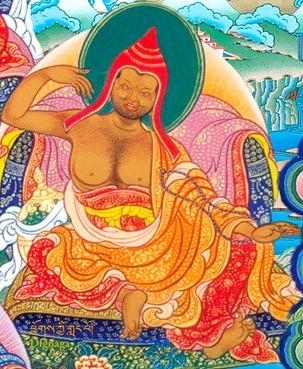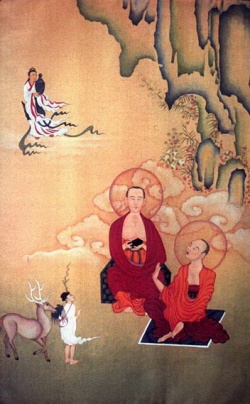Dignaga
Dignaga (Skt. Dignāga; Tib. ཕྱོགས་ཀྱི་གླང་པོ་, Wyl. phyogs kyi glang po; Tib. chok kyi langpo) (circa 6th century AD) was one of the six great commentators (the ‘Six Ornaments’) on the Buddha’s teachings. He was one of the four great disciples of Vasubandhu who each surpassed their teacher in a particular field. Dignaga was more learned than Vasubandhu in pramāṇa.
His reputation as unequaled in debate was cemented through his celebrated victory over the brahmin named Sudurjaya at Nālandā monastery.
Among his disciples was Iśvarasena, who later became the teacher of Dharmakīrti.
Writings
His early (extant) works were:
- The Abhidharmakośa-marma-pradīpa - a condensed summary of Vasubandhu's seminal work
- A brief summary of the Aṣṭasāhasrika-prajñāpāramitā sūtra
His remaining works were all pertaining to logic:
- Ālambana-parīkṣā
- Trikāla-parikṣa
- Hetu-cakra-samarthana
- Nyāyamukha
- Compendium of Valid Cognition (Pramāṇa-samuccaya), which was a condensation of all these works
Further Reading
- Hattori, Masaaki. Dignāga, On Perception. Cambridge, Harvard University Press, 1968.
- Hayes, Richard P. Dignāga on the Interpretation of Signs. Dordrecht, Netherlands: Kluwer, 1988.
Source
Dignāga (c.480-540)
陳那 (n.d.) (Skt; Jpn Jinna)
A south Indian monk and scholar who was an indirect student of Vasubandhu. He combined aspects of Yogācāra and Sautrāntika theories of perception with his own innovative logical methodology (pramāṇa).
Based in Orissa, he wrote a number of important works on Abhidharma and pramāṇa, including his highly influential Pramāṇa-samuccaya. This combines many of his earlier insights into a complete system of epistemology.
The work deals with the problems of sense-perception and its role in knowledge, the reliability of knowledge, and the relationship between sensations, images, concepts, and the external world.
After Dignāga the lineage continued through his pupil Īśvarasena to the great Dharmakīrti in the 7th century.
An Indian scholar of the Consciousness-Only school who lived from the fifth through the sixth century.
Also a scholar of Buddhist logic. Born to a Brahman family in southern India, he studied both Hinayana and Mahayana Buddhism. He further developed the ideas of Vasubandhu and established a branch of the Consciousness-Only school that regarded the images stored in the alaya-consciousness as real rather than non-substantial.
This teaching was inherited by Asvabhava, Dharmapala, Shilabhadra, and Hsüan-tsang. Hsüan-tsang laid the foundation for the Dharma Characteristics (Fa-hsiang) school in China.
Dignaga also contributed to the development of Buddhist logic, advancing a new form of deductive reasoning. His works include The Treatise on the Objects of Cognition, The Treatise on Systems of Cognition, and The Treatise on the Correct Principles of Logic.
Source
Dignāga (Chinese: 陳那論師/域龍, Sanskrit: दिग्नाग, Tibetan: ཕྱོགས་ཀྱི་གླང་པོ་) (c 480-540 CE) was an Indian scholar and one of the Buddhist founders of Indian logic.
He was born into a Brahmin family in Simhavakta (near Kanchi Kanchipuram), and very little is known of his early years, except that he took as his spiritual preceptor Nagadatta of the Vatsiputriya school, before being expelled and becoming a student of Vasubandhu.
This branch of Buddhist thought defended the view that there exists a kind of real personality independent of the elements or aggregates composing it.
Among Dignaga's works there is Hetucakra (The wheel of reason), considered his first work on formal logic, advancing a new form of deductive reasoning. It may be regarded as a bridge between the older doctrine of trairūpya and Dignaga's own later theory of vyapti which is a concept related to the Western notion of implication.
Other works include The Treatise on the Objects of Cognition (Ālambana-parīkṣā), The Treatise on Systems of Cognition (Pramāṇa-samuccaya), and The Treatise on the Correct Principles of Logic (*Nyāya-mukha), produced in an effort to establish what were the valid sources of knowledge.
Contribution to Buddhist Logic
During Dignāga's time, the Nyaya school of Hinduism had began to hold debates using their 5 step approach to making and evaluating arguments with logic. Buddhist debaters such as Dignāga wanted to engage in these debates, and also have a way to logically evaluate arguments, but a premise such as "all dogs are mammals" proved problematic for his idealist Yogacara philosophy. Dignāga was a student of Vasubandhu, and therefore believed that "the dharmas are empty."
In other words, there are not universal qualities such as "dog-ness" or "mammal-ness."
Such universals would have to be unchanging, and since all things are subject to change and are lacking in essential essence according to his school of philosophy, Dignāga attempted to find a way to engage in argument within the Nyaya structure without positing through the arguments that there is an essential "dog-ness," or what have you.
In order to do this he employed what is referred to in formal logic in the West as contraposition, or in sanskrit, Apoha, where one switches the terms and swaps them for their term compliment.
Therefore the example premise above, "all dogs are mammals" becomes "all non-mammals are non-dogs." These two statements are logically equivalent.
Once this had been done, Dignāga could make arguments about non-mammals without positing that mammals have an essential nature.
this move gets off the ground towards his goal, reflection shows that making universal statements about non-mammals still implies that there are mammals who share an essential nature, and everything else, which lacks this "mammal-ness."
Still, using this method Dignāga and other Buddhist logicians were able to further their logical discourse and felt more comfortable engaging in Nyaya structured debates.
{{W}

